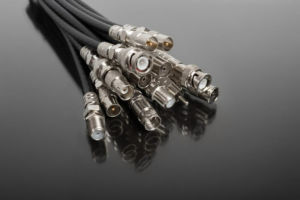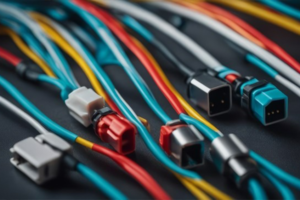In recent years, EVs have transformed the automotive industry, presenting new challenges and opportunities for wiring harnesses—the car’s nervous system.Compared with traditional fuel vehicles, the wiring harness technology of electric vehicles has unique characteristics and development trends. They are leading the transformation of future travel with their unique advantages.
1. Unique challenges of electric vehicle wiring harnesses: high integration and complexity
Electric vehicle wiring harness technology faces challenges that traditional fuel vehicle wiring harnesses do not have. Since the power system, battery management system, electronic control system, etc. of electric vehicles require complex electrical connections, the integration of electric vehicle wiring harnesses is higher and the complexity is also stronger.
1.1 High integration:
Electric vehicles rely on high-voltage, high-current wiring harnesses for their power system, while the battery management system and electronic control system necessitate numerous sensors and actuators. Therefore, electric vehicle wiring harnesses must incorporate additional cables and connectors to fulfill intricate electrical connection demands.
1.2 High complexity:
EV wiring harnesses connect various electronic devices like motors, batteries, chargers, controllers, and sensors, enabling intricate signal transmission and data exchange among them. Therefore, the design and manufacture of electric vehicle wiring harnesses require higher precision and reliability.
2. Development trend of electric vehicle wiring harnesses: lightweight, high performance, and intelligent
In order to meet the unique challenges of electric vehicle wiring harnesses, electric vehicle wiring harness technology is developing in the direction of lightweight, high performance, and intelligence to meet future travel needs.
2.1 Lightweight:
Traditionally, copper wire is used as a conductor in EV wiring harnesses, but its weight hinders range improvement. To reduce harness weight, new materials and technologies are emerging, such as:
Lightweight materials:
Use lightweight materials such as aluminum wire and carbon fiber instead of traditional copper wire to effectively reduce the weight of the wiring harness.
Flat design:
Change the traditional round cable to a flat design to reduce the space occupied by the wiring harness and reduce the weight.
Wiring harness integration: Integrate multiple wiring harnesses together to reduce the number of wiring harnesses and reduce weight.
2.2 High performance:
Electric vehicles have higher performance requirements for electric vehicle wiring harnesses, such as:
High voltage tolerance:
The high voltage system of electric vehicles requires electric vehicle wiring harnesses to withstand higher voltages and ensure safety and reliability.
High current carrying capacity:
The motor of an electric vehicle needs to be powered by high current, and the electric vehicle wiring harness needs to be able to carry a larger current and ensure stable operation.
High anti-interference:
The electronic system of an electric vehicle is very sensitive to electromagnetic interference, and the electric vehicle wiring harness needs to have good anti-interference performance to ensure the accuracy of signal transmission.
2.3 Intelligence:
With the development of automobile intelligence, electric vehicle wiring harnesses also need to have intelligent functions, such as:
Self-diagnosis function:
Electric vehicle wiring harnesses can monitor their own status in real time and issue fault warnings in time to improve driving safety.
Data interaction function:
Electric vehicle wiring harnesses can interact with other vehicle systems to achieve intelligent control and information sharing.
Remote control function:
Electric vehicle wiring harnesses can manage and maintain vehicles through remote control to improve convenience and safety.
3. Future Outlook of Electric Vehicle Wiring Harness: Connecting a New Chapter of Future Travel
The development of electric vehicle wiring harness technology will continue to promote the progress of the electric vehicle industry and bring more possibilities for future travel.
3.1 High integration:
In the future, electric vehicle wiring harnesses will be more integrated, integrating multiple functional modules into one wiring harness, simplifying the wiring harness structure, reducing costs and improving efficiency.
3.2 Intelligent upgrade:
In the future, electric vehicle wiring harnesses will be more intelligent, able to interact with drivers, and provide personalized services according to different driving scenarios.
3.3 Application of new materials:
In the future, electric vehicle wiring harnesses will adopt more new materials, such as superconducting materials, nanomaterials, etc., to further improve the performance and efficiency of wiring harnesses.
3.4 Sustainable development:
In the future, electric vehicle wiring harnesses will pay more attention to sustainable development, adopt environmentally friendly materials, improve recycling rates, and reduce environmental impact.
4. Market status and trends of electric vehicle wiring harnesses:
4.1 Market size:
The global electric vehicle wiring harness market size continues to expand, and is expected to reach tens of billions of dollars by 2025. With the continued growth of electric vehicle sales, the demand for electric vehicle wiring harnesses will continue to rise.
4.2 Competition:
The electric vehicle wiring harness market is highly competitive, and the main players include:
Traditional automotive wiring harness suppliers:
Traditional automotive wiring harness suppliers are actively expanding the electric vehicle wiring harness market, such as Delphi, Leoni, Aptiv, etc.
Emerging wiring harness suppliers:
Some emerging wiring harness suppliers focus on the research and development and manufacturing of electric vehicle wiring harnesses, such as Tesla, CATL, etc.
Electronic component manufacturers:
Some electronic component manufacturers have also begun to get involved in the electric vehicle wiring harness market, such as Bosch, Continental, etc.
4.3 Development trend:
The development trend of the electric vehicle wiring harness market is mainly reflected in the following aspects:
Lightweight:
With the improvement of electric vehicle range, lightweight has become an important development direction for electric vehicle wiring harnesses.
High performance:
Electric vehicles have higher performance requirements for electric vehicle wiring harnesses, such as high voltage tolerance, high current carrying capacity, etc.
Intelligence:
With the development of automobile intelligence, electric vehicle wiring harnesses also need to have intelligent functions, such as self-diagnosis function, data interaction function, etc.
Personalization:
In the future, electric vehicle wiring harnesses will be more personalized and can meet the needs of different models and users.

5. Production management and marketing of electric vehicle wiring harnesses:
5.1 Production management:
The production management of electric vehicle wiring harnesses needs to pay great attention to the following aspects:
Quality control:
The quality of electric vehicle wiring harnesses is crucial, and strict quality control is required during the production process to ensure that the products meet the standards.
Supply chain management:
EV wiring harness production requires abundant raw materials and parts, necessitating a robust supply chain management system for stability and reliability.
Production efficiency:
The production of electric vehicle wiring harnesses requires high efficiency, and advanced production technology and management models need to be adopted to reduce production costs and improve production efficiency.
5.2 Marketing:
The marketing of electric vehicle wiring harnesses needs to focus on the following aspects:
Product differentiation:
The electric vehicle wiring harness market is highly competitive, and it is necessary to highlight the differentiated advantages of products, such as lightweight, high performance, and intelligence.
Customer relationship maintenance:
Electric vehicle wiring harness suppliers need to establish good customer relationships, understand customer needs, and provide high-quality services.
Brand building:
Electric vehicle wiring harness suppliers need to establish their own brands and enhance brand awareness and influence.
6. Future prospects of electric vehicle wiring harnesses:
Electric vehicle wiring harness technology will continue to develop rapidly and bring more possibilities for future travel. In the future, electric vehicle wiring harnesses will develop in the following directions:
High integration:
In the future, EV wiring harnesses will integrate multiple modules, simplifying their structure, cutting costs, and enhancing efficiency.
Intelligent upgrade:
In the future, electric vehicle wiring harnesses will be more intelligent, able to interact with drivers, and provide personalized services according to different driving scenarios.
New material application:
In the future, electric vehicle wiring harnesses will adopt more new materials, such as superconducting materials, nanomaterials, etc., to further improve the performance and efficiency of wiring harnesses.
Sustainable development:
In the future, EV wiring harnesses will prioritize sustainability, using eco-friendly materials, enhancing recycling rates, and minimizing environmental impact.
7. Conclusion:
EV wiring harnesses are vital for electric vehicles, impacting their performance and safety. As the electric vehicle industry rapidly expands, the wiring harness market presents significant development prospects.In the future, electric vehicle wiring harnesses will be more intelligent, lightweight, and high-performance, bringing more possibilities for future travel.
Automotive wiring harness:EV vs. ICE: How Does Wire Harness Design Differ?





